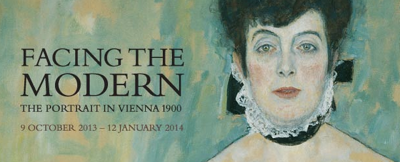
Like football teams most exhibitions have definite stars and Facing the Modern: The Portrait in Vienna 1900 is no exception. At the National Gallery until 12th January 2014 this is a show that does include other artists, but revels in the artistic experiments of Schiele and Kokoschka and the dainty beauty of Klimt. Iconic portraits by these artists are shown with works by less well-known mid-field colleagues such as Broncia Koller and Isidor Kaufmann – this is not a show purely of excellence but rather a survey of the changes in techniques that flourished in the years around 1900 in Vienna.

Through portraiture we learn something of the story of Vienna’s well-to-do residents. Divided amongst six rooms in the basement of the Sainsbury Wing the exhibition starts with The Old Viennese, showing examples of painting from the nineteenth century. These are by artists such as Frederich von Amerling and Ferdinand Georg Waldmüller, whose portraits were rediscovered by the city’s modern artists in 1900. Room two introduces Schiele’s awkward, self-loathing work to the mix whilst later rooms bring in Richard Gerstl and even self-portraits by Arnold Schoenberg. A picture by Alois Deluge, the head of Fine Arts in Vienna allows a reflection on the vast consequences of seemingly small decisions. He was the Professor who turned down the art college application of a young student named A. Hitler.
The exhibition is not hung chronologically, but has pictures juxtaposed to show the difference in style and development of art in 19th and early 20th century Vienna – which until 1918 was the capital of the Austro-Hungarian empire. It was smaller than London or Paris, with fewer patrons willing to spend on modern works, yet there was the typical burgeoning middle class that we read so much about. This was the Vienna of Freud, Mahler and Wittgenstein, and there was an intellectual ferment and a desire to record images and display newly-achieved wealth.
Oskar Kokoschka’s painting of children playing had critics complaining that they were ‘deranged visions from a sick childhood’. They were certainly unlike the portraiture of children which Vienna had been used to, and as his sitters often didn’t show the finished works it is remarkable that he managed to find patrons.
The period under analysis began with democratic reform, economic renewal and ethnic tolerance, but ended with the rise of nationalism and anti-Semitism. Such dramatic changes impacted on the composition and confidence of Vienna’s middle classes, many of them immigrants with Jewish roots or connections. Portraits started as a means to declare their new status but over time served to express their feelings of anxiety and alienation.
If you want feelings of anxiety and alienation then Schiele is your go-to man. Twisted torsos, violently painted leave a strong impression of a powerful self-analysis, if not a peculiarly narcissistic self-loathing. Luckily he was an early developer as he was dead by 28, the first monograph on his work having been published when he was only 21. The head of Klimt’s full-length portrait of Amalie Zuckerkandl is used in the publicity material for the show. This is slightly misleading, as when faced with the original the rest of the painting is unfinished. Klimt was working on it as his death in 1918.
With works on show from such a wide period the 1900 in the title seems arbitrary. Facing the Modern is not a must-see exhibition, but amongst the journeyman works are a few modern masterpieces by those glacatico members of Team Vienna.

Leave a Reply